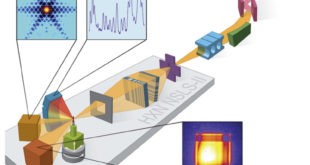The accelerating pace of digitalisation, fuelled by the COVID-19 pandemic, has led to a record-breaking year for cybercrime with ransomware attacks rising 151 per cent in 2021, and an average of 270 cyberattacks per organisation being faced, a new study showed in Jan 2022. The World Economic Forum’s ‘Global …
Read More »Monthly Archives: February 2022
Future digitized Battlefield require Soldier transformation to software experts and data analysts
In an era where technology is the key driver enhancing capabilities across the military, the soldier remains as crucial as ever for achieving mission success. Some of the missions the soldiers perform can take weeks, away from in difficult terrain like deserts and mountains which requires maintaining an incredibly high …
Read More »Automated test and measurement (ATE) for lifesaving, mission-critical, and safety-critical electronics of Defense and Aerospace Systems
The aerospace and defense industry is one of the most massive, and multibillion-dollar industries in operation. This calls for the electronics and technology used in this industry need running at 100% efficiency level to make sure that the equipment doesn’t malfunction and get damaged or provide lower utility than it …
Read More »ROVs for efficient underwater inspection
Ocean shipping continues to be the primary transportation method of billions of dollars in goods. As such a massive industry, safety is incredibly important. Underwater inspection of shipping vessels is important for many reasons. It saves money and time by understanding what is happening under your vessel without diver intervention. …
Read More »Automotive Lightweight Materials
Advanced materials are essential for boosting the fuel economy of modern automobiles while maintaining safety and performance. Because it takes less energy to accelerate a lighter object than a heavier one, lightweight materials offer great potential for increasing vehicle efficiency. A 10% reduction in vehicle weight can result in a …
Read More »Improved Lead-Acid Batteries including lead-crystal and carbon foam batteries making comeback
Virtually every modern naval weapons system, in fulfilling its mission, is highly dependent upon the performance characteristics of its electrochemical power supply. For example, batteries are used to power detection, guidance, control, ignition, propulsion, arming, fuzing, transmitting and jamming devices. The need for weapons with increased range, speed, endurance, sensitivity …
Read More »Critical Infrastructure Protection Market
Networked technologies touch every corner of the globe and every facet of human life. They have driven innovation, nurtured freedoms, and spurred economic prosperity. Even so, the very technologies that enable these benefits offer new opportunities for malicious and unwanted cyber activities. Cyber-attacks are continuously growing in size and breadth, targeting …
Read More »DARPA HACMS employed Formal Verification Methods to develop hack proof unmanned vehicles , weapons , satellites, and command and control systems
In 2011, Iran claimed to have downed a sophisticated American stealth drone, and unveiled what it alleged was a reverse-engineered copy of the futuristic looking RQ-170 Sentinel UAV, produced by defense giant Lockheed Martin. The drone was brought down by the Iranian Armed Forces’ electronic warfare unit which commandeered the …
Read More »DARPA project for cryogenic cables and connectors for quantum computing
Cryogenic electronics is important for a growing number of applications, including superconducting classical computing, superconducting quantum computing and quantum annealing, and superconducting single-photon detector arrays. One of the more difficult aspects about developing a successful superconducting electronics technology at very low temperatures (~10 mK) is the lack of robust commercial …
Read More »DARPA EPIC-HXR developing Hard X-ray imagers
An X-ray, or, much less commonly, X-radiation, is a penetrating form of high-energy electromagnetic radiation. Most X-rays have a wavelength ranging from 10 picometers to 10 nanometers, corresponding to frequencies in the range 30 petahertz to 30 exahertz (30×1015 Hz to 30×1018 Hz) and energies in the range 124 eV …
Read More » International Defense Security & Technology Your trusted Source for News, Research and Analysis
International Defense Security & Technology Your trusted Source for News, Research and Analysis







